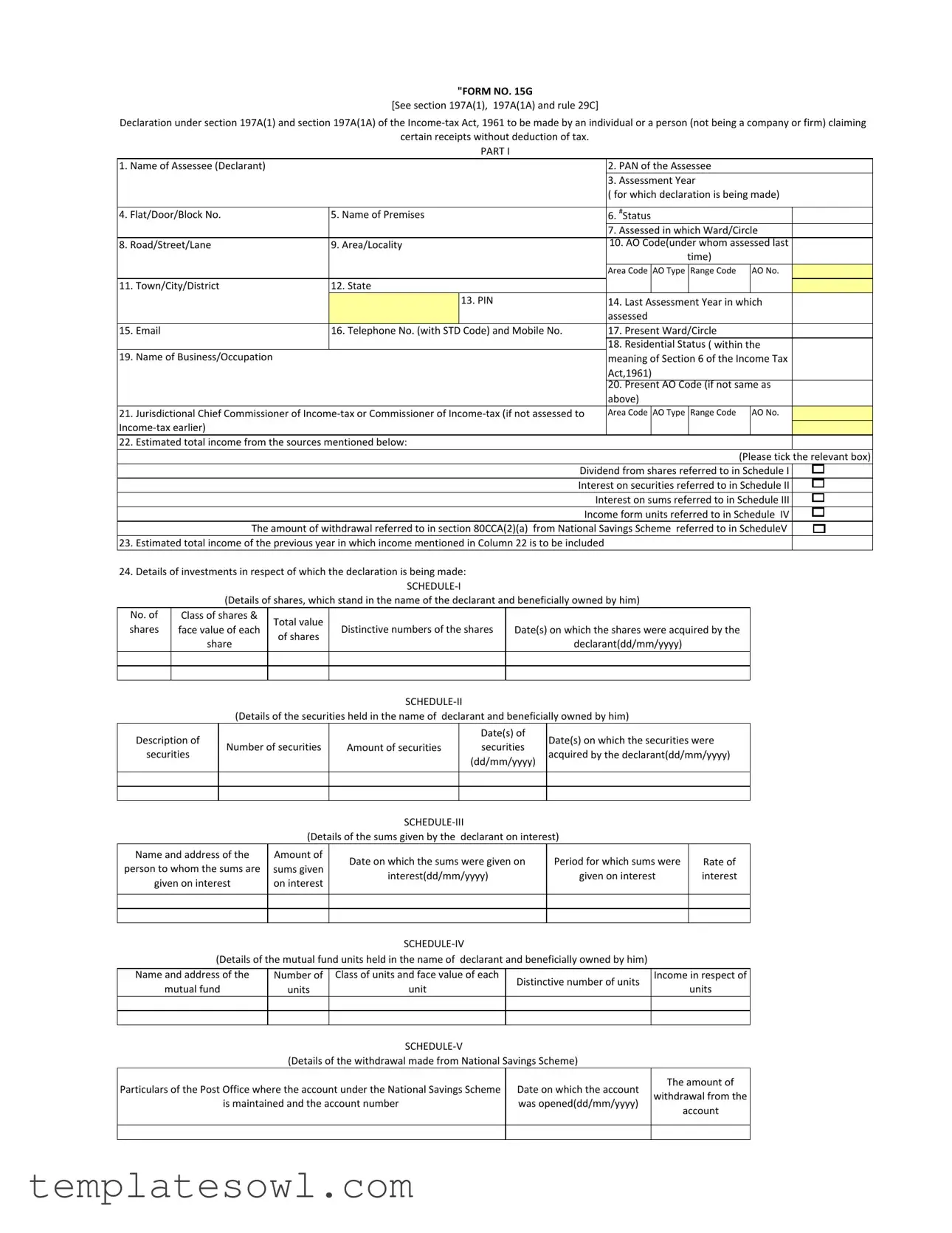Period for which sums were
given on interest
"FORM NO. 15G
[See section 197A(1), 197A(1A) and rule 29C]
Declaration under section 197A(1) and section 197A(1A) of the Income‐tax Act, 1961 to be made by an individual or a person (not being a company or firm) claiming
certain receipts without deduction of tax.
PART I
1. Name of Assessee (Declarant) |
|
|
|
2. PAN of the Assessee |
|
|
|
|
|
|
|
3. Assessment Year |
|
|
|
|
|
|
|
( for which declaration is being made) |
|
|
|
|
|
|
|
|
4. Flat/Door/Block No. |
5. Name of Premises |
|
6. #Status |
|
|
|
|
|
|
|
7. Assessed in which Ward/Circle |
|
8. Road/Street/Lane |
9. Area/Locality |
|
10. AO Code(under whom assessed last |
|
|
|
|
|
|
time) |
|
|
|
|
|
|
|
Area Code |
AO Type |
Range Code |
|
AO No. |
|
11. Town/City/District |
12. State |
|
|
|
|
|
|
|
|
|
13. PIN |
|
14. Last Assessment Year in which |
|
|
|
|
|
assessed |
|
|
|
15. Email |
16. Telephone No. (with STD Code) and Mobile No. |
|
17. Present Ward/Circle |
|
|
|
|
|
|
|
18. Residential Status ( within the |
|
19. Name of Business/Occupation |
|
|
|
meaning of Section 6 of the Income Tax |
|
|
|
|
|
Act,1961) |
|
|
|
|
|
|
|
20. Present AO Code (if not same as |
|
|
|
|
|
above) |
|
|
|
21. Jurisdictional Chief Commissioner of Income‐tax or Commissioner of Income‐tax (if not assessed to |
|
Area Code |
AO Type |
Range Code |
|
AO No. |
|
Income‐tax earlier) |
|
|
|
|
|
|
|
|
|
22. Estimated total income from the sources mentioned below: |
|
|
|
|
|
|
|
|
|
|
|
|
|
|
(Please tick the relevant box) |
|
|
Dividend from shares referred to in Schedule I |
|
|
|
Interest on securities referred to in Schedule II |
|
|
|
|
Interest on sums referred to in Schedule III |
|
|
|
Income form units referred to in Schedule IV |
|
The amount of withdrawal referred to in section 80CCA(2)(a) from National Savings Scheme referred to in ScheduleV |
|
23. Estimated total income of the previous year in which income mentioned in Column 22 is to be included |
|
|
|
24.Details of investments in respect of which the declaration is being made:
SCHEDULE‐I
(Details of shares, which stand in the name of the declarant and beneficially owned by him)
|
No. of |
Class of shares & |
Total value |
|
|
|
|
|
|
shares |
face value of each |
Distinctive numbers of the shares |
Date(s) on which the shares were acquired by the |
|
of shares |
|
|
|
share |
|
|
|
|
declarant(dd/mm/yyyy) |
|
|
|
|
|
|
|
|
|
|
|
|
|
|
|
|
|
|
|
|
|
|
|
|
|
|
|
|
|
|
|
|
|
|
|
|
SCHEDULE‐II |
|
|
|
|
|
|
|
(Details of the securities held in the name of declarant and beneficially owned by him) |
|
Description of |
|
|
|
|
|
Date(s) of |
Date(s) on which the securities were |
|
|
Number of securities |
Amount of securities |
|
securities |
|
securities |
|
|
acquired by the declarant(dd/mm/yyyy) |
|
|
|
|
|
|
(dd/mm/yyyy) |
|
|
|
|
|
|
|
|
|
|
|
|
|
|
|
|
|
|
|
|
|
|
|
|
|
|
|
|
|
|
|
|
|
|
|
|
|
|
|
|
|
|
|
|
SCHEDULE‐III |
|
(Details of the sums given by the declarant on interest) |
Name and address of the |
Amount of |
Date on which the sums were given on |
|
person to whom the sums are |
sums given |
|
interest(dd/mm/yyyy) |
|
given on interest |
on interest |
|
|
|
|
|
|
|
SCHEDULE‐IV
(Details of the mutual fund units held in the name of declarant and beneficially owned by him)
|
Name and address of the |
Number of |
Class of units and face value of each |
Distinctive number of units |
Income in respect of |
|
mutual fund |
units |
unit |
units |
|
|
|
|
|
|
|
|
|
|
|
|
|
|
|
|
|
SCHEDULE‐V |
|
|
|
|
(Details of the withdrawal made from National Savings Scheme) |
|
|
Particulars of the Post Office where the account under the National Savings Scheme |
Date on which the account |
The amount of |
|
withdrawal from the |
|
is maintained and the account number |
was opened(dd/mm/yyyy) |
|
account |
|
|
|
|
|
|
|
|
|
|
|
|
|
|
|
|
|
……………………………………….
**Signature of the Declarant
DECLARATION/VERIFICATION
*I/We………………………………do hereby declare that to the best of *my/our knowledge and belief what is stated above is correct, complete and is truly stated. *I/We
declare that the incomes referred to in this form are not includible in the total income of any other person u/s 60 to 64 of the Income‐tax Act, 1961. *I/We further, declare that the tax *on my/our estimated total income, including *income/incomes referred to in Column 22 above, computed in accordance with the provisions of the Income‐tax Act, 1961, for the previous year ending on .................... relevant to the assessment year ..................will be nil. *I/We also, declare that *my/our
*income/incomes referred to in Column 22 for the previous year ending on .................... relevant to the assessment year .................. will not exceed the maximum
amount which is not chargeable to income‐tax.
Place: |
……………………………………………….. |
|
|
……………………………………………………………. |
Date: |
……………………………………………….. |
|
|
Signature of the Declarant |
|
|
PART II |
|
|
|
|
|
|
[For use by the person to whom the declaration is furnished] |
1. Name of the person responsible for paying the income referred to in Column 22 of Part I |
2. |
PAN of the person indicated in Column 1 of Part II |
|
|
|
|
|
|
3. Complete Address |
|
|
|
|
|
|
|
|
4. |
TAN of the person indicated in Column 1 of Part II |
|
|
|
|
|
|
|
5. Email |
|
6. Telephone No. (with STD Code) and Mobile No. |
|
|
|
|
|
|
|
7. |
Status |
|
8. Date on which Declaration is Furnished |
9. Period in respect of which the dividend has been |
10. Amount of income paid |
11. Date on which the income |
(dd/mm/yyyy) |
declared or the income has been paid/credited |
|
|
has been paid/ |
|
|
|
|
|
|
|
|
|
credited(dd/mm/yyyy) |
|
|
|
|
|
|
|
12. Date of declaration, distribution or payment of dividend/withdrawal under the |
13. Account Number of National Saving Scheme from which withdrawal has |
National Savings Scheme(dd/mm/yyyy) |
been made |
|
Forwarded to the Chief Commissioner or Commissioner of Income‐tax………………………………………………………… |
Place: |
……………………………………………….. |
………………………………………………… |
Date: |
………………………………………………. |
|
Signature of the person responsible for paying the income referred to in Column 22 of Part I
NOTES:
1.The declaration should be furnished in duplicate.
2.*Delete whichever is not applicable.
3.#Declaration can be furnished by an individual under section 197A(1) and a person (other than a company or a firm) under section 197A(1A).
4.**Indicate the capacity in which the declaration is furnished on behalf of a HUF, AOP, etc.
5.Before signing the declaration/verification , the declarant should satisfy himself that the information furnished in this form is true, correct and complete in all respects. Any person making a false statement in the declaration shall be liable to prosecution under 277 of the Income‐tax Act, 1961 and on conviction be punishable‐
i)In a case where tax sought to be evaded exceeds twenty‐five lakh rupees, with rigorous imprisonment which shall not be less than 6 months but which may extend to seven years and with fine;
ii)In any other case, with rigorous imprisonment which shall not be less than 3 months but which may extend to two years and with fine.
6.The person responsible for paying the income referred to in column 22 of Part I shall not accept the declaration where the amount of income of the nature referred to in sub‐section (1) or sub‐section (1A) of section 197A or the aggregate of the amounts of such income credited or paid or likely to be credited or paid during the
previous year in which such income is to be included exceeds the maximum amount which is not chargeable to tax.";


